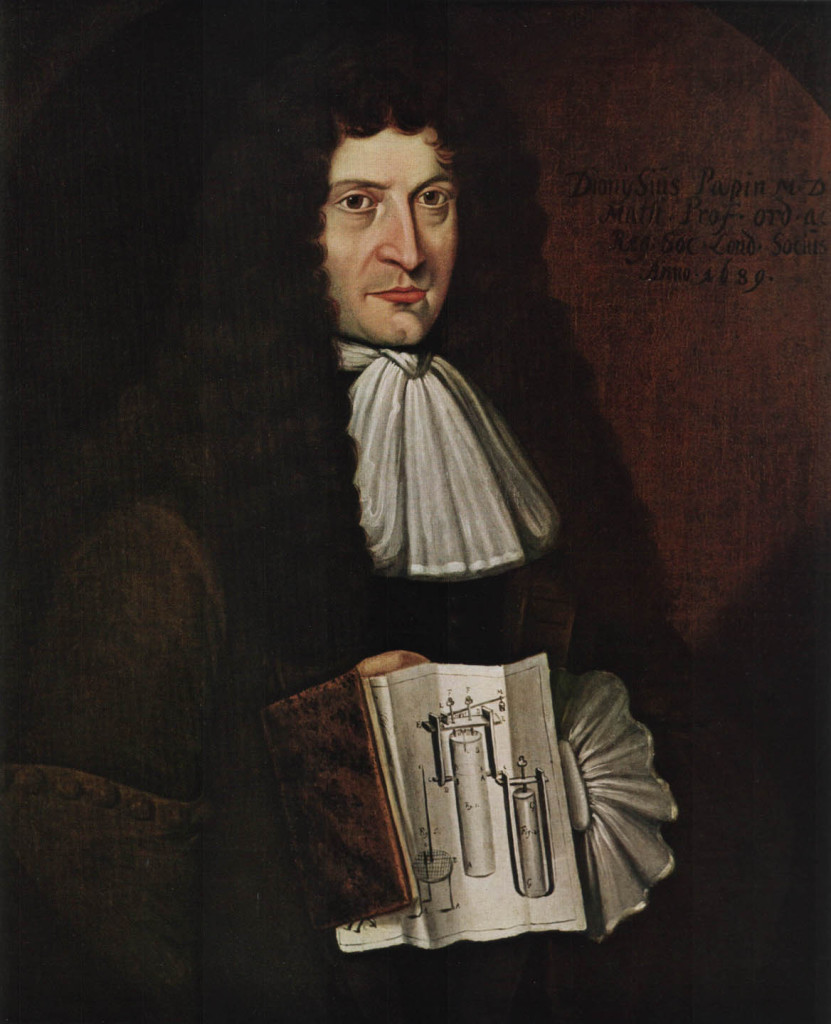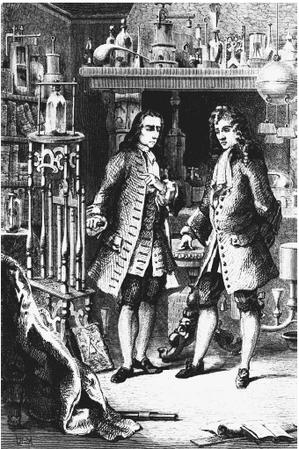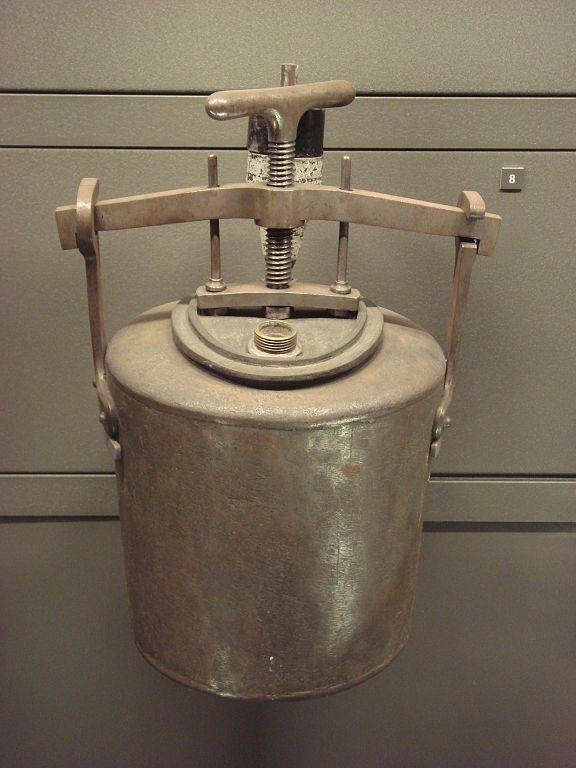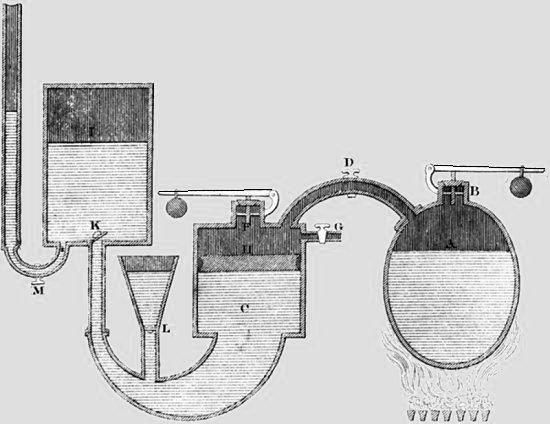
Denis Papin (1647-1712)
On August 22, 1647, French physicist, mathematician and inventor Denis Papin was baptized [2]. He is best known for his pioneering invention of the steam digester, the forerunner of the steam engine, and of the pressure cooker. He never built an effective working engine of his own, but his idea was improved by others and led to the development of the steam engine, a major contribution to the Industrial Revolution.
“Turning a small surface of water into vapour by fire, applied to the bottom of the cylinder that contains it; which vapour forces up the plug (or piston) in the cylinder to a considerable height, and which, as the vapour condenses, (as the water cools when taken from the fire,) descends again by air’s pressure, and is applied to raise water out of the mine.”
– Denis Papin, Letter, as quoted by Robert Stuart Meikleham, A Descriptive History of the Steam Engine (1824)
Papin’s Youth and Education
Born in Chitenay (Loir-et-Cher, Centre Région), France, as the eldest son among thirteen siblings into a Hugenot family, Papin was put into the care of his uncle Nicolas Papin, a medical doctor in Saumur. From 1661 attended University at Angers, from which he graduated with a medical degree in 1669. Papin first intended to follow medicine and went to Paris in 1670 to begin life as a medical doctor. However, he was much more interested in mathematics and mechanics and soon he was bored with medicine. He approached Marie Charron Colbert, the wife of the Controller-General of Finances, Jean-Baptiste Colbert.[5] The Charron and the Papin families were both from Blois so Marie Colbert was an obvious person for Papin to approach looking for support. Colbert had been organising a small group of scholars to meet in the King’s library. Christiaan Huygens,[4] one of the leading scientists of his day, had been persuaded to work in Paris and was a leading member of Colbert’s group. He was looking for an assistant so it was arranged for Papin to fill this role.[2]
Apprenticeship for Christian Huygens
Under Huygens’s supervision, Papin published a book, ‘Nouvelles Expériences du Vuide‘ (Paris, 1674), based on the experiments he had heard about during his apprenticeship including Huygen’s experiments with the air pump. Huygens gave Papin a letter of introduction to Henry Oldenburg, secretary of the Royal Society, in which he asked to arrange for Papin to be introduced to physicist Robert Boyle.[6] Working as Boyle’s assistant, Papin continued with on experiments connected with respiration, magnetism, air, and the chemistry of blood and various medicaments, which he described in his ‘Continuation of New Experiments‘ (1680). During this period, Papin invented the steam digester, a type of pressure cooker with a safety valve. He first addressed the Royal Society in 1679 on the subject of his digester, and published a work in English describing his digester in 1681, namely A new digester or engine for softening bones, containing a description of its make and use.[2]

Robert Boyle and Denis Papin inspecting Papin’s digester
The Steam Digester
Papin’s steam digester was a closed vessel with a tightly fitting lid that confines the steam until a high pressure is generated, raising the boiling point of the water considerably. A safety valve of his own invention prevented explosions. Observing that the enclosed steam in his cooker tended to raise the lid, Papin conceived of the use of steam to drive a piston in a cylinder, the basic design for early steam engines; he never built an engine of his own, however.[1]

A “Papin” cooking pot, late 18th century
Papin’s Steam Engine Research
Papin remained mostly in London until about 1687, when he left to take up a professorship of mathematics at the University of Marburg, Germany. Within a year of taking this position he had invented the earliest form of centrifugal pump, which was used in local drainage work; he applied the same principle to the ventilation of a coal mine. Neither version was widely adopted. In 1696 Papin found a patron in the Landgrave of Hesse-Kassel (Germany), who asked him to build an engine that could lift water to a defined height and then release it into an elevated garden or fountain. Papin’s engine used a free-swimming piston which prevented the steam from condensing on the cold water surface. But, after the joints and valves of the prototype machine leaked, the Landgrave lost all interest in Papin’s work. [3]

Second Papin steam engine (1707). 19th century encyclopedia.
In 1705 the German physicist and philosopher Gottfried Wilhelm Leibniz [7] sent Papin a sketch of the first practical steam engine, built by Thomas Savery of England.[8] Papin and Leibniz had already met in London when Papin was working with Huygens, and have been in academic exchange eversince. That sketch stimulated Papin to further work, culminating in his Ars Nova ad Aquam Ignis Adminiculo Efficacissime Elevandam (1707; “The New Art of Pumping Water by Using Steam”).[1] Recognizing the superiority of Savery’s machine to his own, Papin set out to make improvements to the basic design. His principal improvement was to incorporate a piston, instead of a vacuum chamber, to provide suction.
In 1709 he built a man-powered paddle-wheel boat that successfully demonstrated the practicability of using the paddle wheel in place of oars on steam-driven ships. Later that same year Papin returned to London, where he lived in obscurity until his death.
John Merriman, Industrial Revolutions [10]
References and Further Reading:
- [1] Denis Papin at Britannica Online
- [2] O’Connor, John J.; Robertson, Edmund F., “Denis Papin“, MacTutor History of Mathematics archive, University of St Andrews.
- [3] Denis Papin, at The Robinson Library
- [4] Christiaan Huygens and the Discovery of Saturn Moon Titan, SciHi blog
- [5] The Invention of Financial Politics by Jean-Baptiste Colbert, SciHi Blog
- [6] Robert Boyle – The Sceptical Chemist, SciHi blog
- [7] Let Us Calculate – the Last Universal Academic Gottfried Wilhelm Leibniz, SciHi Blog
- [8] Thomas Savery and the Invention of Steam Power, SciHi Blog
- [9] More articles about steam power at SciHi Blog
- [10] John Merriman, Industrial Revolutions, European Civilization, 1648-1945 (HIST 202), YaleCourses @ youtube
- [11] Denis Papin at Wikidata
- [12] Anita McConnell, ‘Papin, Denis (1647–1712?)’, Oxford Dictionary of National Biography, Oxford University Press, 2004,
- [13] Porezag, Karsten (August 2020). “Denis Papin (1647-1713) in Marburg und Kassel – Erfinder des Prinzips der atmosphärischen Kolbendampfmaschine und des Dampfschiff-Antriebes” [Denis Papin (1647-1713) in Marburg and Kassel – inventor of the principle of the atmospheric piston steam engine and the steamship propulsion]. Hessische Heimat [Hessian homeland]. Hessische Heimat Zeitschrift für Kunst, Kultur und Denkmalpflege (in German) (1/2 ed.). Gesellschaft für Kultur- und Denkmalpflege.
- [14] Timeline for Denis Papin via Wikidata






Pingback: Whewell’s Gazette: Year 2, Vol. #06 | Whewell's Ghost
Pingback: Culinary Innovation – Dinner for two
Pingback: The invention of the pressure cooker. – Know What You Know